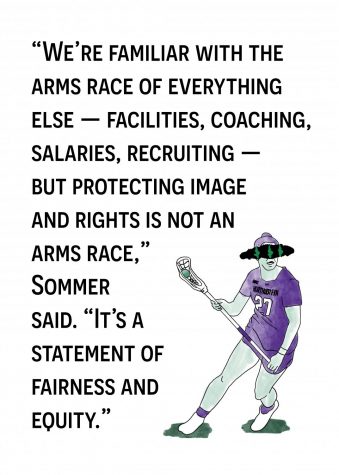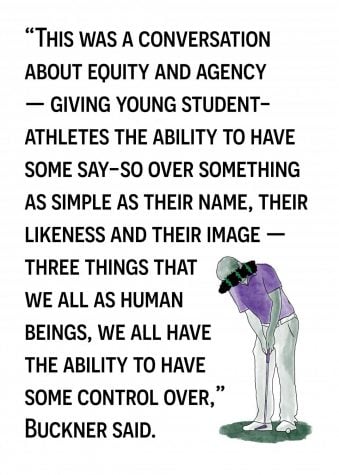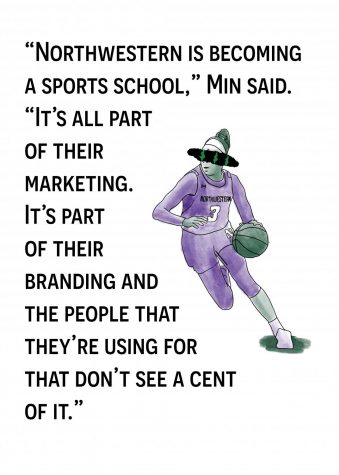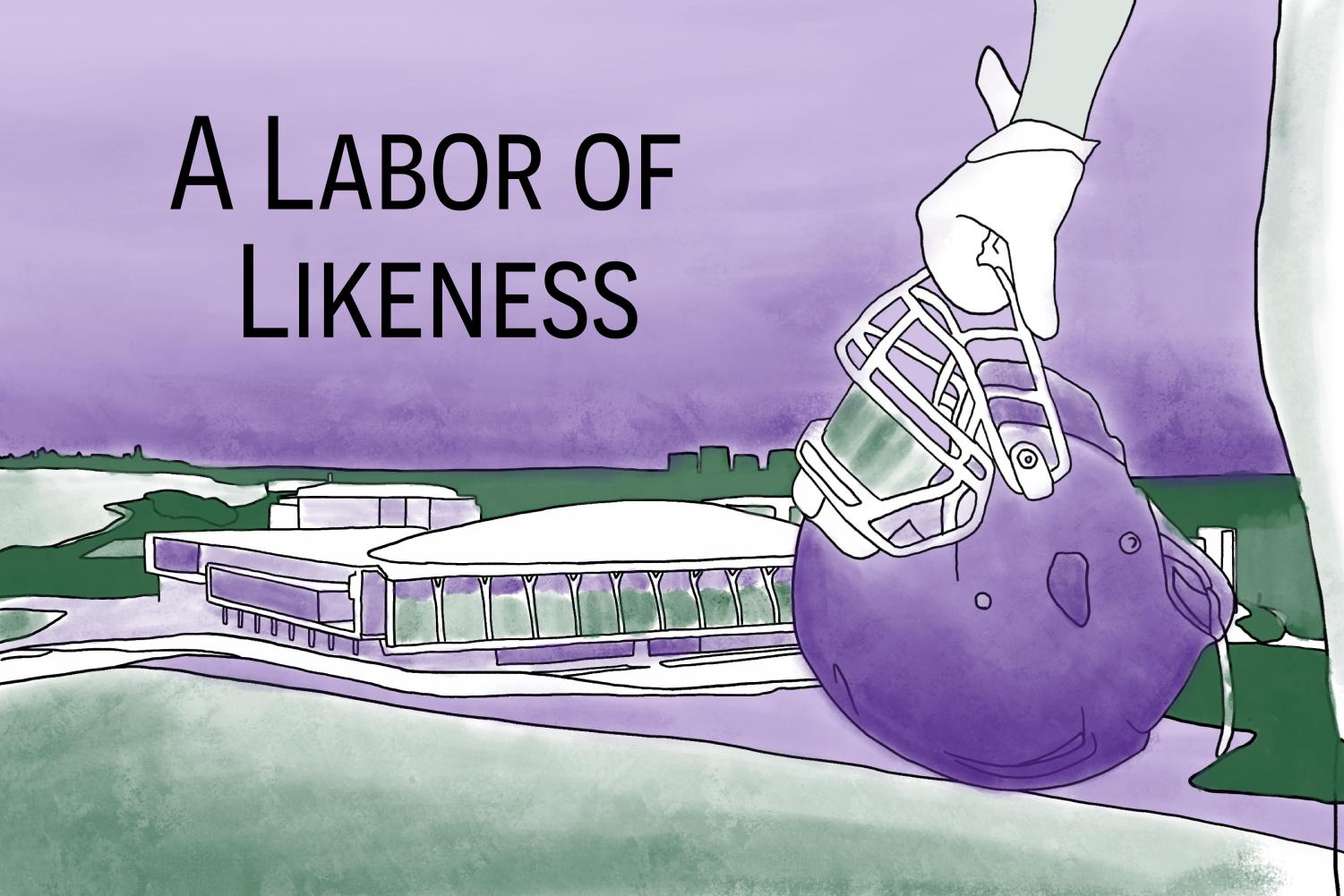In Focus: As state, federal governments grapple with NIL legislation, Northwestern community members reflect on potential impacts
June 8, 2021
If Weinberg junior Cole Sias wants to post on her social media accounts, she could make money with just a few taps.
Sias is a micro-influencer, with over 4,500 followers on Instagram, which means she can leverage her platform with brand deals, receiving money or products for sponsored posts.
But Sias has been a member of Northwestern women’s crew, a club team, and is currently taking a quarter off from the sport. She can accept these deals because she’s not a varsity athlete belonging to the National Collegiate Athletic Association. Though her status as a student-athlete isn’t solely responsible for her social media following, it can dictate how she uses her platform.
The NCAA, the most powerful regulatory body for college athletics nationwide, holds its players to ethical, behavioral and academic standards through a series of regulations. One such directive prohibits players from profiting off their name, image and likeness, often referred to as NIL. The description is a legal term, which can be broadly defined as any form of representation easily identifiable as or connected to the athlete — and it includes social media posts.
Though Sias is now able to post sponsored content because she isn’t bound by NCAA regulations as a club athlete, she said that wasn’t always the case. Before transferring to NU, she was a member of varsity women’s crew at Colby. When she rowed at that level, she said standards were higher.
“One of my friends wanted to be sponsored by Athleta, or something really cool, and couldn’t do it,” Sias said. “Athletes need to monitor social media more and make sure that they’re promoting a good image for the school, which is kind of a big thing to ask college students.”
The NCAA’s reasoning for NIL restrictions is based on the tenet of amateurism, the belief that collegiate athletes aren’t playing at the same level as professionals and therefore shouldn’t be compensated. This lack of compensation forms a key distinction between collegiate and professional athletes and, the NCAA argues, is part of college sports’ appeals to their fans.
“The American collegiate model of intercollegiate athletics has no parallel in the world,” said Bob Bowlsby, commissioner of the Big 12 and a member of the NCAA Board of Governors Federal and State Legislation Working Group, in 2020 Senate testimony on the issue. “To replace or significantly amend the current benefits system we must be able to move ahead with assurance that recruitment can exist and that integrity can be maintained and enhanced.”
Student-athletes also reap the benefits of the income they help collect, the organization claims. Schools reinvest their athletic profits — which primarily come from football and men’s basketball — back into their own departments, including into non-revenue-generating sports. The profits the NCAA receives from championships and other events are also redistributed to support athletes.
However, as college athletics have become increasingly more lucrative, schools and donors have continued to invest money into facilities. Simultaneously, coaching salaries for revenue sports have skyrocketed. Both trends have manifested at NU — the $260 million Ryan Fieldhouse recently opened as the most expensive practice facility in the Big Ten, and football coach Pat Fitzgerald makes over $5.2 million a year as the fourth-highest paid football coach in the conference.

Illinois, another Big Ten school, had an operating budget of over $120 million in the 2019-20 academic year, with over $20 million used to pay coaches. This was a dramatic jump from a decade earlier, when the school spent just under $74 million on athletics, with less than $9 million put toward coaching salaries. And Illinois isn’t alone. The Big Ten as a whole has seen sharp increases in spending over the past decade.
These priorities conflict with the treatment of student-athletes, attorney and NIL advocate Julie Sommer said. Outside of athletic scholarships, she said many student-athletes aren’t seeing benefits that could have a significant impact on their lives.
“We’re familiar with the arms race of everything else — facilities, coaching, salaries, recruiting — but protecting image and rights is not an arms race,” Sommer said. “It’s a statement of fairness and equity.”
The NIL debate has intensified across the country over the past three years, with some states passing laws slated to go into effect as soon as July 1. This March, the U.S. Supreme Court heard oral arguments in NCAA v. Alston, a case centering around NCAA antitrust concerns. If the Court rules against the NCAA, the decision will strike a blow against the organization’s regulatory practices that could pave the way for wider NIL legislation.
In the coming months, athletes and advocates across the nation will watch as the future of NIL discussions hangs in the balance. But at NU, student-athletes and athletic department alumni say a shift in NIL policy could have significant effects.
NU’s Athletic Communications department declined to comment on the current state and potential impact of NIL legislation. The Daily was also unable to speak with any current varsity athletes about the matter due to the department’s decision not to comment.
Forty states and counting
Debates surrounding NCAA player regulations have spanned decades, but it wasn’t until 2019 that any state took a legislative stand on NIL issues in favor of student-athletes.
That September, California Gov. Gavin Newsom signed SB 206, also known as the Fair Pay to Play Act, into law. The bill allows California student athletes to profit off their likeness. Many regarded its passage as a landmark win for NIL advocates and student athletes, spawning a slew of similar proposals across the nation.
When the initial bill was passed, however, the NCAA expressed concerns about the implications of the legislation, which is scheduled to go into effect in 2023.
“A patchwork of different laws from different states will make unattainable the goal of providing a fair and level playing field for 1,100 campuses and nearly half a million student-athletes nationwide,” the NCAA wrote in a 2019 statement in response to the bill’s passage.
Since then, 18 states have passed similar laws. Forty states have introduced some form of NIL legislation, including Illinois, though the state has yet to sign any bills into law.
Democrats filed HB 3904 in the Illinois State House of Representatives in September 2019, which prohibits any university, conference or association from blocking student-athletes’ abilities to profit off their images. It received a wide variety of co-sponsors, including state Rep. Kam Buckner (D-Chicago).
Buckner, a former Illinois football player, told The Daily the bill approached debate at the House level but was a lower priority than other legislation at the time. As a result, the bill stalled and was nullified this January.
During the bill’s legislative review process, Buckner, one of its earliest co-sponsors, said many universities would “fall in line” with the NCAA’s standards for NIL application. Despite this pushback, he said the change remained essential.
Buckner said the successful implementation of these bills in other states could cause harm to Illinois and other states that haven’t passed any NIL-related legislation.
Athletes could find universities in states with approved NIL bills more appealing during the recruiting process, putting Illinois at a disadvantage. Instead of opposing state-level legislation, however, Buckner said this disadvantage makes the passage of an NIL law important for Illinois.
As a result, Buckner said the option remains open for Illinois to reintroduce NIL legislation to ensure universities within the state remain competitive throughout the recruiting process. A bill was introduced in the House this February but does not yet have the same widespread support as the 2019 effort.
Despite this reintroduction, Buckner said state-by-state decisions shouldn’t be as influential as they are currently.
“We shouldn’t have to do this at the statehouse level,” Buckner said. “We shouldn’t have to do this at the federal level. The NCAA should stop nickel-and-diming the young men and women who are under their control and just open it up.”
However, federal legislation may be instrumental in leveling the NIL playing field with a consistent set of regulations.
Less than a month before the first five NIL bills will go into effect, members of the U.S. Senate are racing against the clock. Senators are looking to reach across the aisle before state bills are implemented.
However, differences between liberal and conservative politicians have stalled discussion on the previously bipartisan topic. Both sides have disagreed on the scope of the bill, as well as the way it addresses specific NIL concepts.

The Senate’s Committee on Commerce, Science and Transportation is set to hold a hearing on June 9 discussing the issue, as well as current legislative proposals. If senators don’t reach an agreement, delays past July 1 will separate the states that have passed laws and those that haven’t. This could shape the world of collegiate athletics for years to come.
Buckner said the conversation between legislators is essential, as it becomes a question of fairness and players’ rights.
“This was a conversation about equity and agency — giving young student-athletes the ability to have some say-so over something as simple as their name, their likeness and their image — three things that we all as human beings, we all have the ability to have some control over,” Buckner said.
An imperfect union
NU is no stranger to the intersection of collegiate athletics and labor rights.
In January 2014, a group of football players, including former NU quarterback Kain Colter, announced their plans to unionize as employees of the University. In the months after, NU and universities across the country started conversations about the role of student-athletes as laborers and these players’ relationships with the universities they represent.
An “overwhelming majority” of NU football players supported unionization in 2014, with many signing union cards. According to a 2014 investigation from The Daily, the idea of unionizing was proposed at an impromptu all-team meeting.
Players’ decision to join the union was just one part of a years-long effort to revolutionize NCAA policy. More than a decade earlier, National College Players Association President Ramogi Huma connected with Tim Waters, the United Steelworkers’ Political Director at the time.
The two discussed perceived NCAA injustices for years, Huma said, including limited scholarship and medical support policies that failed to fully address athletes’ needs. Over time, the need for further action became clearer, he told The Daily in 2014.
“There are no employees that are forced to go their jobs — it’s all voluntary,” Huma said in a 2014 interview on “The Colbert Report,” an infotainment program. “But that doesn’t mean you shouldn’t have a voice in your workplace to make sure you have basic protections.”
The NCPA worked as an advocacy group for years, but Huma said he grew frustrated with the organization’s limited scope. When Colter reached out to the NCPA and proposed unionization, Huma said the two groups were ready to take their organizing to the next level.
The resulting movement prompted significant debate across the collegiate world on the subject of athletes’ rights. For 18 months, members of the proposed athletic union advocated for the recognition of collegiate athletes as University employees. The case was sent to the National Labor Relations Board for review, and despite the months of advocacy, it eventually failed.
The NLRB unanimously declined to rule on the case in August 2015. This effectively reversed the decision the board’s Chicago office made in March 2014 decreeing that the players’ union should have been recognized. Though the union never received national recognition, Colter said the discussions it prompted may have impacted the current state of NIL debate, beginning conversations about athletes’ rights as employees.
In 2019, Colter told The Daily the University’s response followed the narratives of a “typical union-bashing campaign.” Retrospectively, he said he felt the movement had the potential to spark significant change, but many of its opponents thought it could destabilize the culture of college athletics.
Despite the movement’s eventual failure, Colter said the work of NU athletes in 2014 and 2015 paved the way for current discussions about NIL policies and changes that are in the works.
“Our effort was (about) the right to free association and some sort of democratic participation and these rules and regulations that we have to live by,” Colter told The Daily at the time. “Being able to have rights to your name, image and likeness is a huge component of that.”
The need for proportional payment
Senior fencer Isabella Min said student-athlete responsibilities often limit additional commitments. She has weighed the opportunities that could come from a part-time job, and said if she opted to take one on, she would lose out on other parts of the college experience — a decision she said wouldn’t be worth it for her.
As a result of the high commitment levels sports require, Min said many athletes choose to focus on academics and sports, which can cause financial difficulties for some students looking to join collegiate teams.
“There’s not a single athlete I know who has (a part-time job),” Min said. “You can’t do work study, you can’t get a part-time job — it’s literally impossible.”
Jack Dunn (Weinberg ’19), a former NU shortstop, said this disparity was incredibly evident during his time at the University. He described playing baseball for the Cats as a “full-time job,” with required practices six days a week. In addition, he said most of his teammates went into the weight room or practiced on their days off to ensure they remained in the best shape possible.
However, Dunn said this time commitment was not reflected in baseball scholarships, as players don’t all receive funding, and even those who do may not accrue the same amount. He added that the program received limited financial backing from the University.
Though athletes receive other forms of support, such as priority registration, special tutoring and professional development programs, these methods of aid may not address the needs of all players, especially those who need more financial support than what they’re given by the University.
Dunn, who was drafted and now plays in the minor leagues, said legislation allowing student-athletes to profit off their image could make a significant difference in their lives.
“Baseball is not a full ride,” Dunn said. “Any time you can make some money using your image and likeness, that would be a good thing.”
Most years, NU baseball has over two dozen players, but the University can only offer up to the financial equivalent of 11.7 full scholarships for the sport, according to NCAA rules, though the money can be divided between athletes however the University sees fit. Associate Athletic Director of Communications Paul Kennedy told The Daily the University typically gives out 11.2 baseball scholarships each year. As a result, Dunn said the chance to profit could be important for players in sports with low scholarship counts, as not all players will get scholarships, and even those who do may not have their needs met.
Dunn, who currently plays for the Wilmington Blue Rocks, an affiliate of the Washington Nationals, said other opportunities exist outside revenue-generating sports, meaning the implementation of NIL legislation could benefit all athletes.
He said collegiate athletes could utilize their status as a member of a higher level team to host training camps and lessons in the offseason, for example, which he currently does as a baseball instructor.
Dunn’s status as a professional athlete gives him credibility with children and families, he said. In many cases, the same philosophies could hold true for college athletes, especially those at well-known universities, he said.
As universities increase their reliance on sports for marketing purposes, Min said fair compensation becomes more important for athletes. This issue expands past schools in the Big Ten and SEC, which are both well-known for their athletic prominence, she said.
Other Power Five schools are leveraging different sports to their marketing advantages. The University of California, Los Angeles, for example, has marketed its gymnastics team to widespread appeal, she said.
However, Min said this attention rarely reflects back on student-athletes in a proportional manner. Across the Big Ten, universities’ direct returns of profits to students through scholarships make up just under 12 percent of athletic operating budgets — a smaller portion than coaches’ compensation. This disproportionate payment, Min said, is unfair for student-athletes.

“Northwestern is becoming a sports school,” Min said. “It’s all part of their marketing. It’s part of their branding and the people that they’re using for that don’t see a cent of it.”
Bridging the gender gap
The two top-revenue sports, football and men’s basketball, box women out from profiting on high-profile athletic participation. However, social media can provide a different avenue for profit.
According to marketing firm Opendorse, just 16 of the top 30 most-followed athletes on social media play the two highest-earning sports, which means non-revenue sports can generate income for players as well.
For many NIL advocates, this highlights the potential for financial equity across sports. Jayma Meyer, a professor at Indiana University who focuses on student-athlete legislation and Title IX policy, said social media has given every athlete an equal shot at Internet stardom, making NIL policy changes even more important.
“The big opportunity really is on social media,” Meyer said. “If you have a personality, a lot of pizzazz, you don’t necessarily have to be a star athlete to have a lot of followers. And that certainly has been shown in the last year or two.”
Sias, the rower, is familiar with the inner workings of social media. Through multiple internships, she’s cultivated social media feeds of larger companies, and she is also a part of multiple groups of collegiate influencers.
She said she’s seen many opportunities for athletes to implement social media strategies for their own financial gain. Several current NU athletes have already gained traction online, Sias said, and NIL changes would further incentivize them.
Athletes with large followings at NU aren’t limited to revenue-generating sports either. Volleyball senior Alana Walker has garnered over 200,000 TikTok followers and 160,000 Instagram followers — a higher count on a single platform than some prominent members of NU football.
Sias said social media success can come from a combination of intentional content and athletes’ built-in fanbases, and athletes would need to be deliberate about their posts if they want to profit off these proposed NIL changes.
“A lot of it is really attracting the followers, and also the potential followers.” Sias said. “Some Northwestern athletes have tens of thousands of followers because they’re well-known for their sport, but also because they post stuff that pertains to what their followers want to see.”
Investing in a new market
If successfully passed — and implemented — NIL legislation could change the current student-athlete economy. And NCAA v. Alston, the ongoing Supreme Court case, may play a pivotal role in that transformation.
The case looks at the existing regulations on forms of compensation student-athletes can receive from their universities. The gifts under discussion, which the NCAA does not currently allow universities to distribute, cannot be cash but could arguably be related to athletes’ education, such as musical instruments, computers or potentially even internships. In oral arguments for the case, the NCAA claimed that amateurism is a key part of the appeal of its athletic contests, and even these non-cash gifts could hurt that appeal for many fans.
With a decision expected by the end of June, this case will shape the federal legality and implementation of NIL legislation, establishing precedent for years to come.
The NCAA Board of Directors unanimously voted in favor of altering the organization’s NIL policies to reflect the changing athletic landscape in 2019. But the NCAA has yet to implement any changes, with its 2020-21 athletic policy continuing to restrict athletes’ compensation rights.
If these changes go into effect, the industry could see individuals and universities redefine their interactions with athletes.
School of Professional Studies Prof. Scott Kirkpatrick teaches in NU’s Sports Administration graduate program while serving as a partner at Chicago Sports and Entertainment Partners. Based on his experiences at NU and in the industry, Kirkpatrick said he expects athletic agents to play a key role in the industry if NIL restrictions change.
Kirkpatrick said agents will be able to help athletes navigate negotiation processes in brand deals and other opportunities. However, due to the extreme surplus of college athletes in comparison with professionals, he said the market could look completely different. Instead of negotiating on an athlete-by-athlete basis, Kirkpatrick said brands, universities and agents might need to think bigger.
“If they’re going to want to get into the college market, they’re going to be looking at a way in which they can buy 100 campuses and 1,000 athletes, not one at a time,” he said.
Under this model, businesses could collaborate with universities to launch large-scale coordinated campaigns on social media, with budgets divided to reflect individual athletes’ followings. Kirkpatrick said this creates a more equitable economy for athletes in non-revenue sports.
However, the format Kirkpatrick proposed is just one of many methods NIL legislation changes could be implemented. Until bills go into effect, it’s hard to predict how the changes will shake out — but Kirkpatrick said universities will also need to adjust the way they regulate athletes’ public images.
University President Morton Schapiro told The Daily that NU has supported state-level NIL legislation, and is open to implementing policy changes that allow student-athletes to profit off their image.
Schapiro, a labor economist by trade and current chair of the Big Ten Council of Presidents/Chancellors, said his experiences have informed his stance on the creation of NIL policy.
“I never understood those restrictions to trade, personally,” Schapiro said. “As long as we all operate under the same rules, in my view, it’s the right thing to do.”
Sias said a system of institutional support around NIL legislation will be important for athletes’ success on and off the field as NU prepares for potential changes. This spring, she decided to take time off from her sport because of its extensive time commitment. She had a part-time job, took a full course load and attended rowing practices in the team’s off-season this winter, which didn’t feel feasible to repeat, she said.
As a result, Sias said NIL bills will be essential in allowing student-athletes to focus more on their respective classes and sports — which would benefit universities and students alike. Student-athletes and their schools are inextricably intertwined, she said, which will be important to consider as they look toward the future.
“In some ways, it’s (athletes’) lives,” Sias said. “But in other ways, they really are kind of a figurehead for Northwestern. So that definitely can be a weird balance.”
Email: fulton@u.northwestern.edu
Twitter: @jacobnfulton
Related stories:
— Former NU quarterback Kain Colter talks California bill, 2013 Ohio State game
— NLRB declines to rule on Northwestern union, ending CAPA movement
— In Focus: From locker room to courtroom: How the union movement came to Northwestern

